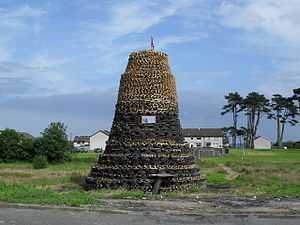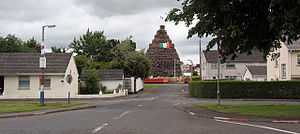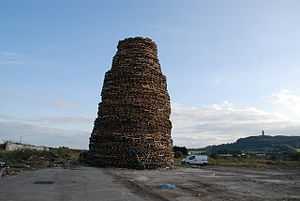Eleventh Night

In Northern Ireland, the Eleventh Night or 11th Night refers to the night before the Twelfth of July, a yearly Ulster Protestant celebration. On this night, large towering bonfires are lit in many Protestant unionist neighbourhoods in Northern Ireland.[1] The bonfires are mostly made up of wooden pallets and tires, with some reaching over 100 ft tall.[2] They are often accompanied by street parties. The event has been condemned for displays of sectarian or ethnic hatred, and for the damage and pollution caused by the fires. The flag of Ireland, symbols of Irish nationalism/republicanism, Catholic symbols, and effigies, are often burnt on the fires. It is also known as "bonfire night", in common with other events in which bonfires are lit.[3][4][5]
Origins
Like The Twelfth itself, the Eleventh Night is associated with the Glorious Revolution (1688) and Williamite–Jacobite War in Ireland (1689–91). Tradition holds that the bonfires commemorate the lighting of fires on the hills of counties Antrim and Down to help Williamite ships navigate through Belfast Lough at night.[6] Protestant King William III and his forces landed at Carrickfergus to fight the Catholic Jacobites; supporters of the exiled Catholic King James II, who was trying to regain the British throne.
Bonfires in Northern Ireland traditionally mark the night before the Twelfth. However, should the Twelfth fall on a Sunday, as it did in 2009, the public holiday is given in lieu on the preceding Monday. This means that some bonfires may also be held on a Sunday night.
Criticism


Sectarianism and violence
Eleventh Night bonfires have involved sectarian and loyalist paramilitary displays. Symbols of Irish nationalism/republicanism (such as the Irish tricolour), and symbols of Catholicism, are often burnt on the bonfires.[1][6] The tricolours on such bonfires are often daubbed with sectarian slogans such as "Kill All Taigs" (KAT) or "Kill All Irish" (KAI).[7][8] Effigies, and posters of Irish nationalist election candidates, are also sometimes burnt, which has been condemned as "inciting hatred".[9] More recently, symbols of various immigrant communities, especially the large Polish immigrant community, have been burnt on the fires. The Polish Association of Northern Ireland, and others, have described this as "racist intimidation".[10]
Loyalist paramilitaries, such as the Ulster Defence Association (UDA) and Ulster Volunteer Force (UVF), have also used Eleventh Night bonfires to hold "shows of strength" – which often involve masked gunmen firing volleys of shots into the air.[1]
Another issue that has been raised is drunkenness and alcohol-fuelled violence amongst those attending.[1]
Environmental harm
Eleventh Night bonfires have raised health and safety concerns, as well as environmental ones.[1][11]
Bonfires are often built to be as large as possible. Some have been built near houses and other buildings. Roads are often damaged and, according to the British Broadcasting Corporation, clean-up and repairs made to roads due to bonfire-related damage can "cost thousands of pounds", with some roads needing to be resurfaced.[1]
A major concern that has risen to greater prominence in recent years is the pollution they cause. In some bonfires, despite bans by bodies such as Belfast City Council, tyres are burnt. Tyres produce many toxic chemical compounds when burnt, and therefore pose a major health issue.[1]
Attempts to address the concerns
There have been attempts to make the bonfires more family-friendly and environmentally-friendly. In Belfast, a Bonfire Initiative has been set up. When joining the initiative, the community groups who organize bonfires agree to a number of conditions. A "bonfire committee" must be formed; the gathering of material for burning may only begin on 1 June; only wood can be burnt; and paramilitary flags and emblems must not be displayed at the bonfire site. In 2010, groups who forbore from burning nationalist flags or symbols were awarded an extra £100 funding.[6]
In 2009, Belfast City Council began promoting "beacons" as an environmentally-friendly alternative. It is a pyramid-shaped metal cage filled with willow wood-chips, and set on a base of sand to protect the ground underneath. The willow trees re-grow within a year of being cut down, making the bonfires more environmentally sustainable. By agreeing to use the beacons, the communities qualify for up to £1,500 of funding from Belfast City Council to hold a street party – as long as they do not fly paramilitary flags or burn tyres. Some loyalist communities in Belfast have begun using the beacons. The Orange Order, whilst recognising the importance of bonfires to Protestant culture, have issued calls for the organisers of bonfires not to burn tyres.[12] However, many others oppose the beacon, claiming that it infringes upon their traditions.[1]
References
- ↑ 1.0 1.1 1.2 1.3 1.4 1.5 1.6 1.7 Mark Simpson (10 July 2009). "Turning hotspot into friendly fire". BBC News. Retrieved 13 July 2009.
- ↑ "The leaning tyres of Belfast: Protestants pile up incredible bonfires as they prepare for inflammatory celebration of Battle of the Boyne". The Daily Mail. 10 July 2013. Retrieved 11 July 2014.
- ↑ Simpson, Mark (12 July 2004). "Damping down the flames". BBC News Online. BBC. Retrieved 2011-07-17.
[...] went out with one of the crews on their busiest night of the year - Bonfire Night. It is the eleventh hour of the eleventh night [...]
- ↑ "Village bonfire night hit and run driver ‘was fleeing mob’". The Belfast Telegraph (Independent News & Media). 4 August 2010. Retrieved 2011-07-17.
- ↑ Santino, Jack (1998). The hallowed eve: dimensions of culture in a calendar festival in Northern Ireland. Lexington, Kentucky: University Press of Kentucky. p. 54. ISBN 978-0-8131-2081-2. Retrieved 2011-05-18.
While the term Bonfire Night once referred to Halloween, in Northern Ireland today it refers to the Eleventh Night [...]
- ↑ 6.0 6.1 6.2 "The boy and the bonfire". Belfast Telegraph, 9 July 2010.
- ↑ Bowcott, Owen (13 July 2006). "Army off streets for July 12". The Guardian (London).
- ↑ http://www.anphoblacht.com/news/detail/32731
- ↑ " Limavady bonfire: Election posters 'inciting hatred', says Sinn Féin" BBC News
- ↑ "Poland flags burned on bonfires across Belfast on 11 July"BBC News19 July 2012
- ↑ "Health fears over burning tyres". BBC News. 11 July 2007. Retrieved 13 July 2009.
- ↑ "Orange Order appeals for no tyres to be burned on 11th night bonfires" The Newsletter